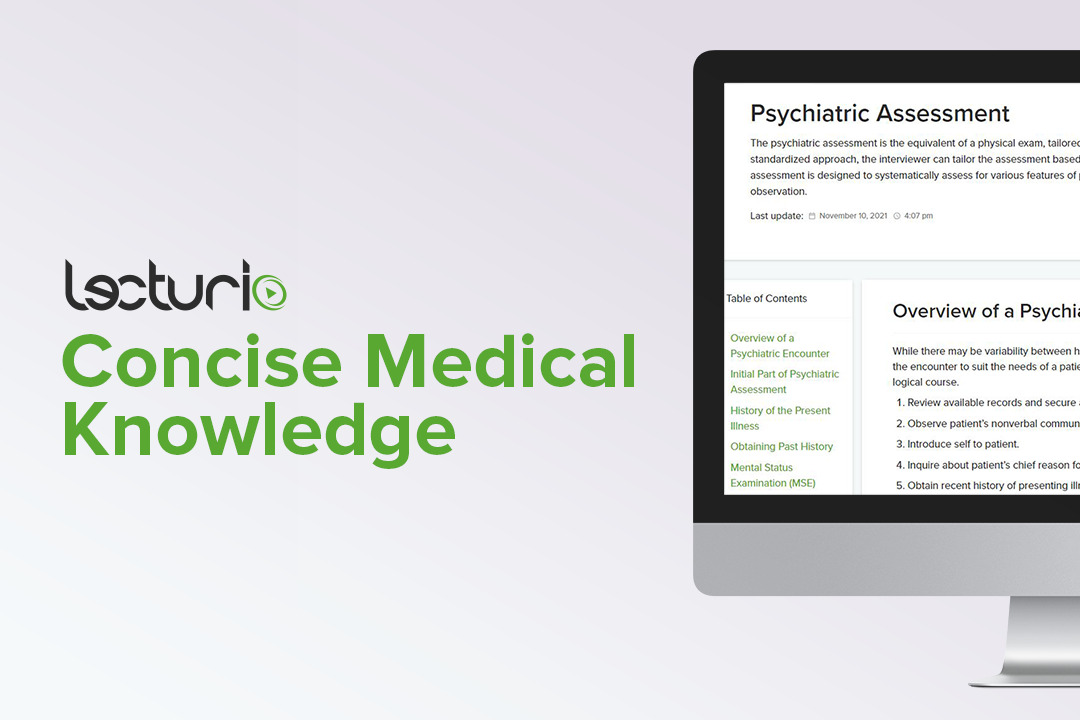Playlist
Show Playlist
Hide Playlist
Suicide Risk Assessment
-
Slides Components of the Mental Status Examination.pdf
-
Download Lecture Overview
00:01 We're going to take a little bit of time now to talk about the suicide risk assessment, something that is critical to Psychiatry and a very important point, so make sure you're paying attention here. So suicide is defined as the intentional taking of one's own life, and there are several risk factors that can play into the suicide risk assessment. 00:25 So there can be passive suicidal ideation. This is, for example in clinical practice where you might meet a patient who says, 'Gosh doctor, my life is not going well right now and I sometimes wish I wouldn't wake up in the morning.' They have no active plan or intent to hurt themselves. It's a very passive wish to die. Active suicidal ideation is very different. 00:49 This is where you encounter a patient who says to you, 'Doctor, I'm not happy with my life. 00:53 I want to end it and I own a gun and therefore I'm going to use that to hurt myself.' That would be active suicidal ideation. The patient actually has an intent and a plan to do something in the example I just gave. Sometimes you will encounter a patient who has a plan but sometimes they don't have the intent. They'll come to you and say, 'Doctor, I'm not happy with my life. I thought of shooting myself. 01:16 However, I'd actually like to feel better. Can you help me? I don't want to carry out that plan.' So very important to understand the patient's thought, intent, and plan. 01:27 And then there is also parasuicidal behavior, and this is where there's self-injury not intended to cause death, but actually just intended to harm oneself. 01:38 So this could often be seen in clinical practice as a patient who will cut themselves, burn themselves, maybe bang their head, and again their intent is not actually to die, it's to inflict self-harm. The problem is sometimes these patients will go on though to accidentally cause their own death. So very important to always screen for self-injurious behaviors. 02:01 When thinking about suicide and self-harm, there are static risk factors, meaning things that don't change, for that patient. There are modifiable risk factors. 02:12 This is very important because this is where you as a doctor can actually step in and help that patient make some positive interventions in their lives where they can change things. 02:22 And then there are protective factors. Also very important to note in your risk assessment because you want to build up on the protective factors to best help your patient. 02:34 So let's review these in a little bit more detail. Okay, so what do you think are the static risk factors, things that are unchanging. Well here are a few. Let's go through them. So age is one. 02:47 We find there's a bi-modal peak for suicide. So people who are at particular risk include those aged 15-24 and also the elderly, those over 60 or 65 years old. 02:59 Race is also an unchangeable demographic risk factor. 03:05 So we find that Caucasians and Native Americans are at highest risk statistically speaking. 03:11 Also sex is an important variable. Women are actually three times more likely to attempt suicide. 03:19 However, men are far more likely to complete suicide. There also can be a history of suicide attempts. 03:28 This is a huge risk factor. We often think of history as being a big risk factor for what may come in the future. So very important to know whether or not your patient has had a history of suicide attempts. Taking it one step further, if your patient does have a history of suicide attempts, you want to ask more questions such as what was the attempt, noting whether it was violent or nonviolent, you want to know whether or not it led to a hospitalization, did your patient reach out for help or not, did they write a suicide note, etc. Also consider family history of suicide attempts. 04:05 This is very important and you want to know if your patient has any history of physical or sexual abuse. 04:11 Here are some modifiable risk factors, and I want to encourage you to think about how you could actually modify these things so you can be helpful to your patients. 04:22 All right, so mental illness. Things like depression, anxiety and feeling hopeless, which is a really key feature for a lot of patients who are feeling suicidal. 04:33 So this can be modified by actually treating the mental condition that's happening and depression and anxiety are a couple of things. Of course, there are a lot of mental disorders that can lead to suicidal thinking. Whatever it is, make sure that the patient's in treatment, that they're getting medication and a supportive system of providers that can help them through their conflict. General medical conditions. This is another thing that can actually be changed. 05:01 So we think of things like chronic pain or end-stage diseases as having high risks for suicide. 05:08 But you can help that patient by making sure they are in fact accessing good medical care. 05:13 Make sure they have a primary care provider, someone who's a point person for them to reach out to so their questions are answered, so they have an idea of what's to come and so their families are also being supported with them through their medical illness. 05:27 You also can enhance a patient's professional support system. 05:31 So you want to make sure they have access to good psychiatric care whether it's therapy, case managers, social workers, so refer them out in your community. 05:40 Make sure that they have the help that they need. Another hugely variable and modifiable risk factor for suicide and self-harm is substance abuse. So this is something that you can intervene upon by educating your patient about the dangers of substance use, encouraging them to seek out some sober or rehab programs. Substances can lead to disinhibitions making it far more likely for someone to carry out a self-injurious behavior. So you want to make sure that you explore this with your patient and provide them with appropriate education. 06:14 Also ask about guns and access to weapons. You can modify this by providing education to the patient and with their permission to their family about the dangers of having weapons in the home. You also want to explore your patient, their employment and community supports. 06:31 Having a job or a school, a place to go where somebody feels part of a community and like they're working towards a goal goes a long way in helping people feel hopeful for tomorrow. 06:44 So you may want to refer your patient if they're not working or employed to a vocational program. 06:49 You might want to help them with finances by getting enrolled in disability if they qualify. 06:54 You might want to enhance their supports by referring them to group programs or community outreach programs where they can, depending on their level of function, engage in some sort of work support or hobbies. So just make sure that they're connected within their community. Anniversary of losses such as deaths are very triggering for people who are already feeling down and so you want to explore this with the patient. 07:22 It's modifiable in that while they may be experiencing the anniversary of a loss, you can help your patient make sure that they actually have an outlet to talk about their grief and look forward to meeting with someone who might understand whether it's one-to-one or a peer support group. Protective factors are extremely important to consider as well because as I said, these are things that you can build upon with your patient and sometimes even just reminding a patient that they do have some positives in their lives can go a long way in helping them to not feel so self-injurious or suicidal. 08:00 So ask them about supports and build upon them financial stability, employment and jobs, marriage and relationships whether or not they have children, their level of intelligence meaning their ability to work in a group or get employed and get a job. 08:18 You want to know about that level of education if their currently in school or not if they like to go back to school, whether or not they have stable housing and their history of resiliency. Another thing that's really important as a protective factor is whether or not somebody has a religious community because again, community can really help to save lives. So we've reviewed here a lot about the mental status exam and also suicide risk assessment. Some key things to keep in mind are that that mental status exam in Psychiatry is really akin to the physical exam in Internal Medicine. 08:53 It's extremely important and warrants your attention and as well, the suicide risk assessment needs to be done at every patient encounter so you can build upon modifiable and protective risk factors and really help to keep your patients safe. Thank you.
About the Lecture
The lecture Suicide Risk Assessment by Helen Farrell, MD is from the course Psychiatric Assessment.
Included Quiz Questions
All the following items are static risk factors for suicide, except?
- Feeling of hopelessness
- Family history of suicide attempts
- Sex of the patient
- Race of the patient
- Past suicide attempts
All of the following are protective factors for suicide, EXCEPT:
- Low education level
- Level of intelligence
- Employment
- History of resiliency
- Stable housing
A patient says she owns a gun and intends to use it to kill herself. What type of suicidal ideation is she displaying?
- Active suicidal ideation
- Passive suicidal ideation
- Active homicidal ideation
- Initiative suicidal ideation
- Static suicidal ideation
All the following are modifiable risk factors for suicide, EXCEPT:
- History of physical or sexual abuse
- Substance use
- General medical conditions (e.g. chronic pain, end-stage cancer)
- Underlying mental illness (e.g. depression, anxiety)
- Professional supports (e.g. access to psychiatric care)
A patient with suicidal intention has access to guns/weapons. How can this risk factor be modified?
- Educate about removing the firearms from the home
- Refer to vocational training programs
- Treat him with SSRIs
- Teach him how to use the firearms
- Refer to community therapy
Customer reviews
5,0 of 5 stars
| 5 Stars |
|
5 |
| 4 Stars |
|
0 |
| 3 Stars |
|
0 |
| 2 Stars |
|
0 |
| 1 Star |
|
0 |





